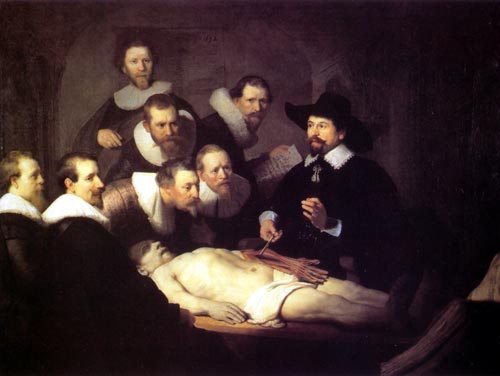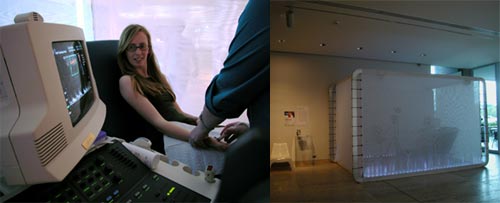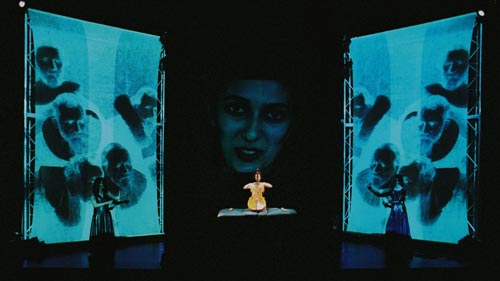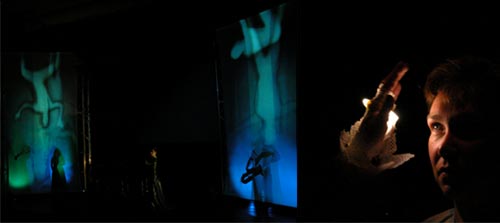ELISION Ensemble | Justine Cooper | John Rodgers
Introduction | Artist's statements | Song texts | Press | Performances | Trailer [20mb mpeg4 quicktime]

Rembrandt's 1632 painting - The Anatomy Lesson of Dr. Nicolaes Tulp
![]()

A visitor generating sound through the Ultrasound
machine with the aid of a vascular technologist (left). The booth installation
on site at the Art Gallery of New South Wales (right).
![]()

ELISION Ensemble's Genevieve Lacey, Rosanne Hunt
(center) and Deborah Kayser performing TULP, Sydney Festival 2004.
photo:
Alex Craig

Soprano Deborah Kayser on stage with ELISION musicians
behind latex projection screens (left), Kayser scanning audience members
with a wireless surveillance camera (right).

On January 16th, 1632 the executed body of convicted thief Adriaan Adriaanzoon
alias Aris Kindt was dissected by Dr Nicolaes Tulp in front of an interested
audience comprising some of the most important burghers of the city of
Amsterdam. The incision displaying the tendons in the arm of the unfortunate
Mr Kindt was documented in the Rembrandt painting The Anatomy Lesson of
Dr Nicolaes Tulp and was something of a first; in previous times the Catholic
Church having forbade dissection of the human cadaver for fear of discovery
of the soul's location.
The painting occupies a territory somewhere between medicine and art and
both documents and expresses the power relationships that surround that
particular investigation into the human body. Issues of consent, of who
gets to frame the defining societal questions of medicine and religion,
and how the body public is subsequently interrogated are as pertinent
in our times as in those of Rembrandt and his contemporaries.
The 2004 Sydney performance was preceded by the installation of a booth
equipped with an ultrasound machine at the Art Gallery of New South Wales
last December. The booth enabled the visual artist Justine COOPER
to interview volunteer members of the general public who then provided
the narratives, the audio-visual samples of their body and speech that
form a `library´ from which we could select our performance vocabulary.
TULP, the body public is a cycle in twelve sections. Conceptually for
the artists it is a cycle that is organic but which is disrupted and punctuated
by moments conceived of as `surgical´ , as interventionist in nature.
Soprano Deborah KAYSER
viewed as a `vector´ by Justine Cooper mediates between audience,
musicians and sampled narratives. Information rides upon her. She gives
voice to songs drawn from the early Baroque, fragments of Monteverdi,
Merula and others; all composers for whom the music of affections was
a significant doctrine determining the objectivity of sound in relationship
to the human frame. Images reflect upon and around her. She surveys the
audience and that surveillance injects the seated audience into the performance
enquiry.
Period instruments from the early Baroque are used. But recorders, theorbo,
sackbuts, and guitars are performed upon with the inevitable awareness
of contemporary techniques and sensibilities while electronic manipulation
is used to excavate within the theatre and amongst the audience an invisible
set of chambers and cavities delineated by sound. Improvisation collides
with notated materials.
The latex screens are the site where musicians and their the instruments,
themselves exploited bodies, provide the locus for the intersection of
text, sound, and the visual. They are `alternative spaces´ where
sounds create and deform images, and images double back upon themselves
to speak to us and to each other.
We see the public body in this performance as being comprised of the audience
as contributors, those who consented to our enquiries in the booth, the
musicians and performers, as well as the resultant body of knowledge and
art on display. Ultimately while being a artwork about medicine, as with
the Rembrandt, it is not didactic. TULP, the body public is not a closed
story. Rather it is a work reflective of the ongoing narrative and relationships
that humans form with the experience of their own bodies.
--Daryl BUCKLEY